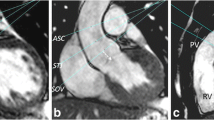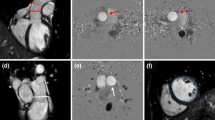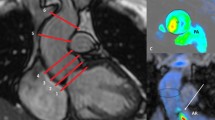Abstract
Background
Phase-contrast magnetic resonance (MR) has been widely used for quantification of aortic regurgitation. However there is significant practice variability regarding where and how the blood flow data are acquired.
Objective
To compare the accuracy of flow quantification of aortic regurgitation at three levels: the ascending aorta at the level of the right pulmonary artery (level 1), the aortic valve hinge points at end-diastole (level 2) and the aortic valve hinge points at end-systole (level 3).
Materials and methods
We performed cardiovascular MR in 43 children with aortic regurgitation. By using phase-contrast MR, we measured the systolic forward, diastolic retrograde and net forward flow volume indices at three levels. At each level, the following comparisons were made: (1) systolic forward flow volume index (FFVI) versus left ventricular cardiac index (LVCI) measured by cine ventricular volumetry; (2) retrograde flow volume index (RFVI) versus estimated aortic regurgitation volume index (which equals LVCI minus pulmonary blood flow index [QPI]); (3) net forward flow volume index (NFVI) versus pulmonary blood flow index.
Results
The forward flow volume index, retrograde flow volume index and net forward flow volume index measured at each of the three levels were significantly different except for the retrograde flow volume index measured at levels 1 and 3. There were good correlations between the forward flow volume index and the left ventricular cardiac index at all three levels, with measurement at level 2 showing the best correlation. Compared to the forward flow volume indices, the retrograde flow volume index had a lower correlation with the estimated aortic regurgitation volume indices and had widely dispersed data with larger prediction intervals.
Conclusion
Large variations in systolic forward, diastolic retrograde and net forward flow volumes were observed at different levels of the aortic valve and ascending aorta. Direct measurement of aortic regurgitation volume and fraction is inaccurate and should be abandoned. Instead, calculation of the aortic regurgitation volume from more reliable data is advised. We recommend subtracting pulmonary blood flow from systolic forward flow measured at the aortic valve hinge points at end-diastole as a more accurate and consistent method for calculating the volume of aortic regurgitation.









Similar content being viewed by others
References
Tafreshi RI, Shahmohammadi A, Davari PN (2005) Predictors of left ventricular performance after valve replacement in children and adolescents with chronic aortic regurgitation. Pediatr Cardiol 26:331–337
Bonow RO, Carabello BA, Kanu C et al (2006) ACC/AHA 2006 guidelines for the management of patients with valvular heart disease: a report of the American College of Cardiology/American Heart Association task force on practice guidelines (writing committee to revise the 1998 Guidelines for the Management of Patients With Valvular Heart Disease): developed in collaboration with the Society of Cardiovascular Anesthesiologists: endorsed by the Society for Cardiovascular Angiography and Interventions and the Society of Thoracic Surgeons. Circulation 114:e84–e231
Selamet Tierney ES, Gal D, Gauvreau K et al (2013) Echocardiographic predictors of left ventricular dysfunction after aortic valve surgery in children with chronic aortic regurgitation. Congenit Heart Dis 8:308–315
Cox DA, Walton K, Bartz PJ et al (2013) Predicting left ventricular recovery after replacement of a regurgitant aortic valve in pediatric and young adult patients: is it ever too late? Pediatr Cardiol 34:694–699
d’Udekem Y, Siddiqui J, Seaman CS et al (2013) Long-term results of a strategy of aortic valve repair in the pediatric population. J Thorac Cardiovasc Surg 145:461–467
Myerson SG, D’Arcy J, Mohiaddin R et al (2012) Aortic regurgitation quantification using cardiovascular magnetic resonance. Association with clinical outcome. Circulation 126:1452–1460
Mauer G (2006) Aortic regurgitation. Heart 92:994–1000
Sechtem U, Pflugfelder PW, Cassidy MM et al (1988) Mitral or aortic regurgitation: quantification of regurgitant volumes with cine MR imaging. Radiology 167:425–430
Aurigemma G, Reichek N, Schiebler M et al (1991) Evaluation of aortic regurgitation by cardiac cine magnetic resonance imaging: planar analysis and comparison to Doppler echocardiography. Cardiology 78:340–347
Globits S, Frank H, Mayr H et al (1992) Quantitative assessment of aortic regurgitation by magnetic resonance imaging. Eur Heart J 13:78–83
Dulce MC, Mostbeck GH, O’Sullivan M et al (1992) Severity of aortic regurgitation: interstudy reproducibility of measurements with velocity-encoded cine MR imaging. Radiology 185:234–240
Søndergaard L, Lindvig K, Hildbrandt P et al (1993) Quantification of aortic regurgitation by magnetic resonance velocity mapping. Am Heart J 125:1080–1090
Honda N, Machida K, Hashimoto M et al (1993) Aortic regurgitation: quantification with MR imaging velocity mapping. Radiology 186:189–194
Chatzimavroudis GP, Walter PG, Oshinski JN et al (1997) Slice location of aortic regurgitation measurements with MR phase velocity mapping. Magn Reson Med 37:545–551
Chatzimavroudis GP, Oshinski JN, Franch RH et al (1998) Quantification of the aortic regurgitant volume with magnetic resonance phase velocity mapping: a clinical investigation of the importance of imaging slice location. J Heart Valve Dis 7:94–101
Kozerke S, Schwitter J, Pedersen EM et al (2001) Aortic and mitral regurgitation: quantification using moving slice velocity mapping. J Magn Reson Imaging 14:106–112
Gelfand EV, Hughes S, Hauser TH et al (2006) Severity of mitral and aortic regurgitation as assessed by cardiovascular magnetic resonance: optimizing correlation with Doppler echocardiography. J Cardiovasc Magn Reson 8:503–507
Ley S, Eichhorn J, Ley-Zaporozhan J et al (2007) Evaluation of aortic regurgitation in congenital heart disease: value of MR imaging in comparison to echocardiography. Pediatr Radiol 37:426–436
Gabriel RS, Renapurkar R, Bolen MA et al (2011) Comparison of severity of aortic regurgitation by cardiovascular magnetic resonance versus transthoracic echocardiography. Am J Cardiol 108:1014–1020
Bolen MA, Popovlc ZB, Rajlah P et al (2011) Cardiac MR assessment of aortic regurgitation: holodiastolic flow reversal in the descending aorta helps stratify severity. Radiology 260:98–104
Cawley PJ, Hamilton-Craig C, Owens DS et al (2013) Prospective comparison of valve regurgitation quantitation by cardiac magnetic resonance imaging and transthoracic echocardiography. Circ Cardiovasc Imaging 6:48–57
Sen S, Srivastava MS (1990) Regression analysis: theory, methods, and applications. Springer, New York
Cleveland WS (1993) Visualizing Data. Hobart Press, Summit, NJ
R Development Core Team (2012) A language and environment for statistical computing. R Foundation for Statistical Computing, Vienna, Austria. http://www.R-project.org/. Accessed 12 May 2014
Kilner PJ, Gatehouse PD, Firmin DN (2007) Flow measurement by magnetic resonance: a unique asset worth optimizing. J Cardiovasc Magn Reson 9:723–728
Goo HW, Al-Otay A, Grosse-Wortmann L et al (2009) Phase-contrast magnetic resonance quantification of normal pulmonary venous return. J Magn Reson Imaging 29:588–594
Jetsch M, Klass RO, Aschoff J et al (2008) Evaluation of accordance of magnetic resonance volumetric and flow measurements in determining ventricular stroke volume in cardiac patients. Acta Radiol 49:530–539
Kayser HW, Stoel BC, van der Wall EE et al (1997) MR velocity mapping of tricuspid flow: correction for through-plane motion. J Magn Reson Imaging 7:669–673
Westenberg JJ, Roes SD, Ajmone Marsan N et al (2008) Mitral valve and tricuspid valve blood flow: accurate quantification with 3D velocity-encoded MR imaging with retrospective valve tracking. Radiology 249:792–800
Roes SD, Hammer S, van der Geest RJ et al (2009) Flow assessment through four heart valves simultaneously using 3-dimensional 3-directional velocity-encoded magnetic resonance imaging with retrospective valve tracking in healthy volunteers and patients with valvular regurgitation. Invest Radiol 44:669–675
Conflicts of interest
None
Author information
Authors and Affiliations
Corresponding author
Rights and permissions
About this article
Cite this article
Iwamoto, Y., Inage, A., Tomlinson, G. et al. Direct measurement of aortic regurgitation with phase-contrast magnetic resonance is inaccurate: proposal of an alternative method of quantification. Pediatr Radiol 44, 1358–1369 (2014). https://doi.org/10.1007/s00247-014-3017-x
Received:
Revised:
Accepted:
Published:
Issue Date:
DOI: https://doi.org/10.1007/s00247-014-3017-x




